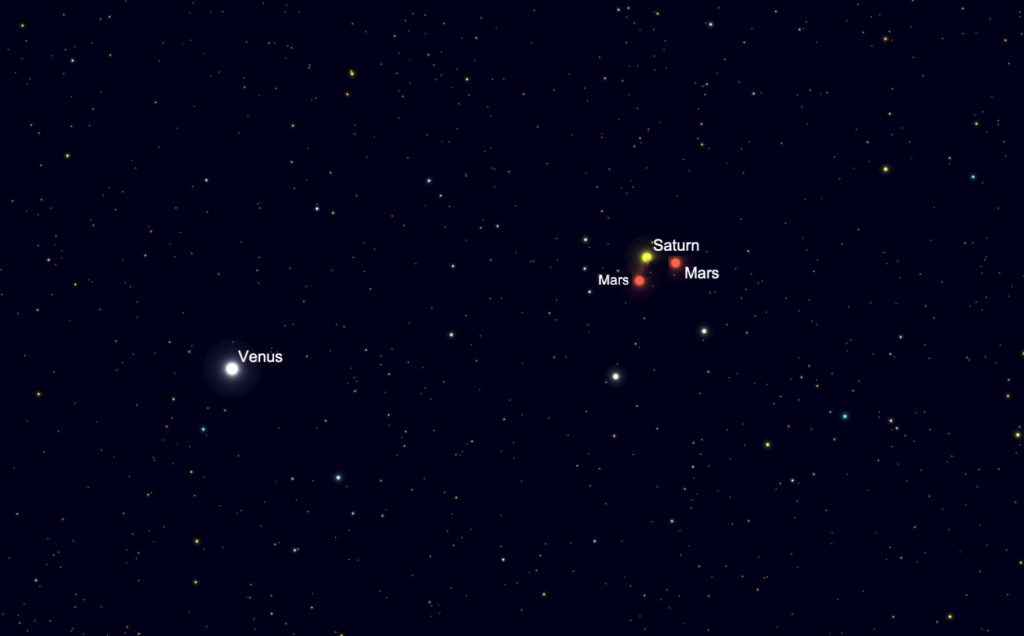Sky Report: April 4-10

Mars is within ½° of Saturn on April 4 (lower right) and April 5 (lower left). Both are 7° to the right of brilliant Venus.
Graphic created with SkySafariAstronomy.com.
There was a wonderful grouping of the planets in the morning sky on March 28, and it’s followed by two beautiful very close conjunctions in April. Don’t let the fact that they take place in the morning deter you – half of all astronomical events take place in the morning, and with Daylight Time the sun rises late so you don’t have to get up unreasonably early to see the morning planets.
The first of the two April conjunctions takes place on the mornings of Monday, April 4th and Tuesday, 5th. An hour before sunrise spot Venus, which is brilliant low in the southeast, about 10° above the horizon (it’s higher later, of course). 7° straight to the right of Venus are the two planets Mars and Saturn. They’re only 1/100th as bright as Venus, but there are no stars similarly bright nearby so you’ll have no trouble spotting them. The three will barely fit in the view of wide-angle binoculars. Relative to the background stars Mars is moving 3/4° eastward each day, passing Saturn on the 4th and 5th, and on each of those two mornings Mars is a scant ½° from Saturn. That’s the width of the full moon and it’s especially close – so close that on both mornings you can see both planets together in a telescope eyepiece – a very rare sight you won’t want to miss.
With binoculars you may, and with any telescope you will, see the phase of Venus, which is half-full, like a tiny first-quarter moon. A telescope at 30X or more will show Saturn’s rings, and any instrument will show the contrasting colors between Venus – pure white, Saturn – yellow, and Mars – pale orange.
Mars then moves on eastward away from Saturn, toward Venus, but Venus is moving eastward even faster and Mars won’t catch it. You can easily watch this chase with binoculars – and if you’re a stargazer who regularly reads this column you definitely need binoculars, and an adequate pair of 7X50 will set you back less than $50 if you shop around.
Venus’ eastward motion is carrying it toward Jupiter, which is just now reappearing from behind the sun, and these two brightest planets will be in a fantastic conjunction at the end of the month. Stay tuned.
A nice sight awaits stargazers on the evening of Monday, April 4, when the moon sits only 4° from the Pleiades star cluster, aka “The Seven Sisters”. The moon is a slim crescent only 14% lit by the sun, and all but high-power binoculars will show both the moon and the star cluster at the same time. Look for “The Old Moon in the Young Moon’s Arms” – earthshine that lets you see seas and major craters on the dark side of the moon. The moon passes the Pleiades every month but it seldom comes so close and even more rare does it pass close when it’s a thin crescent, so don’t miss this opportunity, which is also a photo opp.
Thanks to a 2021 grant from the Utah Governor’s Office of Economic Opportunity and the Kane County Office of Tourism, Stellar Vista Observatory offers portable telescopes and tripod mounted binocular kits on loan for free to all residents of Kane County. Nothing beats a quality binocular or astronomical telescope to enhance enjoyment of the night sky!
Visit https://stellarvistaobservatory.org/discover-the-night-sky/ or Kanab City Library for full details.
The Sky Report is presented as a public service by the Stellar Vista Observatory, a nonprofit organization based in Kanab, Utah, which provides opportunities for people to observe, appreciate, and comprehend our starry night sky. Additional information is at www.stellarvistaobservatory.org. Send questions and comments to John@StargazingAdventures.org.






Comments are closed.